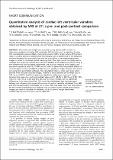Files in this item
Quantitative analysis of cardiac left ventricular variables obtained by MRI at 3 T : a pre- and post-contrast comparison
Item metadata
| dc.contributor.author | Matthew, S. | |
| dc.contributor.author | Gandy, S. J. | |
| dc.contributor.author | Nicholas, R. S. | |
| dc.contributor.author | Waugh, S. A. | |
| dc.contributor.author | Crowe, E. A. | |
| dc.contributor.author | Lerski, R. A. | |
| dc.contributor.author | Dunn, M. H. | |
| dc.contributor.author | Houston, J. G. | |
| dc.date.accessioned | 2013-08-06T11:01:05Z | |
| dc.date.available | 2013-08-06T11:01:05Z | |
| dc.date.issued | 2012-07 | |
| dc.identifier | 63102805 | |
| dc.identifier | cb18044c-7c6c-42c9-afd0-f4e4e50adf1d | |
| dc.identifier | 000306995300017 | |
| dc.identifier | 84863642086 | |
| dc.identifier.citation | Matthew , S , Gandy , S J , Nicholas , R S , Waugh , S A , Crowe , E A , Lerski , R A , Dunn , M H & Houston , J G 2012 , ' Quantitative analysis of cardiac left ventricular variables obtained by MRI at 3 T : a pre- and post-contrast comparison ' , The British Journal of Radiology , vol. 85 , no. 1015 , pp. E343-E347 . https://doi.org/10.1259/bjr/62891785 | en |
| dc.identifier.issn | 0007-1285 | |
| dc.identifier.uri | https://hdl.handle.net/10023/3927 | |
| dc.description.abstract | Short-axis cine images are acquired during cardiac MRI in order to determine variables of cardiac left ventricular (LV) function such as ejection fraction (EF), end-diastolic volume (EDV), end-systolic volume (ESV), stroke volume (SV) and LV mass. In cardiac perfusion assessments this imaging can be performed in the temporal window between first pass perfusion and the acquisition of delayed enhancement images in order to minimise overall scanning time. The objective of this study was to compare pre- and post-contrast short-axis LV variables of 15 healthy volunteers using a two-dimensional cardiac-gated segmented cine true fast imaging with steady state precession sequence and a 3.0 T MRI unit in order to determine the possible effects of contrast agent on the calculated cardiac function variables. Image analysis was carried out using semi-automated software. The calculated mean LV mass was lower when derived from the post-contrast images, relative to those derived pre-contrast (102 vs 108.1 g, p<0.0001). Small but systematic significant differences were also found between the mean pre- and post-contrast values of EF (69.4% vs 68.7%, p<0.05), EDV (142.4 vs 143.7 ml, p<0.05) and ESV (44.2 vs 45.5 ml, p<0.005), but no significant differences in SV were identified. This study has highlighted that contrast agent delivery can influence the numerical outcome of cardiac variables calculated from MRI and this was particularly noticeable for LV mass. This may have important implications for the correct interpretation of patient data in clinical studies where post-contrast images are used to calculate LV variables, since LV normal ranges have been traditionally derived from pre-contrast data sets. | |
| dc.format.extent | 5 | |
| dc.format.extent | 183429 | |
| dc.language.iso | eng | |
| dc.relation.ispartof | The British Journal of Radiology | en |
| dc.subject | Cardiovascular magnetic resonance | en |
| dc.subject | Mass | en |
| dc.subject | Reproducibility | en |
| dc.subject | Sequences | en |
| dc.subject | SSFP | en |
| dc.subject | Q Science | en |
| dc.subject | R Medicine | en |
| dc.subject.lcc | Q | en |
| dc.subject.lcc | R | en |
| dc.title | Quantitative analysis of cardiac left ventricular variables obtained by MRI at 3 T : a pre- and post-contrast comparison | en |
| dc.type | Journal article | en |
| dc.contributor.institution | University of St Andrews. School of Physics and Astronomy | en |
| dc.identifier.doi | 10.1259/bjr/62891785 | |
| dc.description.status | Peer reviewed | en |
This item appears in the following Collection(s)
Items in the St Andrews Research Repository are protected by copyright, with all rights reserved, unless otherwise indicated.

